Human DDX17 Unwinds Rift Valley Fever Virus Non-Coding RNAs
Abstract
1. Introduction
2. Results
2.1. Purification of DDX17135–555, RVFV S-segment IGR, and 5′NCR
2.2. Solution Conformation of DDX17135–555, RVFV S-Segment IGR, and 5′NCR
2.3. DDX17 Binds to the IGR and 5’NCR Non-Coding RNAs
2.4. DDX17 Unwinds RVFV RNA in an ATP-Dependent Fashion
3. Discussion
4. Materials and Methods
4.1. Protein Expression and Purification of DDX17135–555
4.2. Preparation of Rift Valley Fever Virus Non-Coding RNAs
- 1.
- RVFV NCR S Segment 812–886
- 2.
- RVFV IGR S Segment 25–100
4.3. Fluorescent Labeling of RNA
4.4. Analytical Ultracentrifugation (AUC)
4.5. Microscale Thermophoresis RNA and Protein Binding Studies
4.6. Helicase Assay
4.7. Small-Angle X-ray Scattering
Author Contributions
Funding
Institutional Review Board Statement
Informed Consent Statement
Data Availability Statement
Acknowledgments
Conflicts of Interest
Abbreviations
| MST | Microscale Thermophoresis |
| AUC | Analytical Ultracentrifugation |
| ncRNA | Non-coding RNA |
| rRNA | Ribosomal RNA |
| IGR | Intergenic Region |
| SAXS | Small-angle X-ray Scattering |
| 5′ NCR | 5′ Non-coding RNA |
| SV | Sedimentation Velocity |
| BSA | Bovine Serum Albumin |
| RVFV | Rift Valley Fever Virus |
| FITC | Fluorescein Isothiocyanate |
| RNA | Ribonucleic Acid |
| FPLC | Fast Protein Liquid Chromatography |
| HPLC | High-performance liquid chromatography |
| PAGE | Polyacrylamide Gel Electrophoresis |
| SEC | Size-Exclusion Chromatography |
References
- Findlay, G.; Daubney, R. The Virus of Rift Valley Fever or Enzootic Hepatitis. Lancet 1931, 25, 229–248. [Google Scholar] [CrossRef]
- Balkhy, H.H.; Memish, Z.A. Rift Valley fever: An uninvited zoonosis in the Arabian peninsula. Int. J. Antimicrob. Agents 2003, 21, 153–157. [Google Scholar] [CrossRef]
- Bird, B.H.; Ksiazek, T.G.; Nichol, S.T.; MacLachlan, N.J. Rift Valley fever virus. J. Am. Vet. Med. Assoc. 2009, 234, 883–893. [Google Scholar] [CrossRef] [PubMed]
- Ikegami, T. Rift Valley fever vaccines: An overview of the safety and efficacy of the live-attenuated MP-12 vaccine candidate. Expert Rev. Vaccines 2017, 16, 601–611. [Google Scholar] [CrossRef] [PubMed]
- WHO. Rift Valley Fever Virus; WHO: Geneva, Switzerland, 2020. [Google Scholar]
- Linthicum, K.; Davies, F.; Kairo, A.; Bailey, C. Rift Valley fever virus (family Bunyaviridae, genus Phlebovirus). Isolations from Diptera collected during an inter-epizootic period in Kenya. Epidemiol. Infect. 1985, 95, 197–209. [Google Scholar] [CrossRef]
- Nanyingi, M.O.; Munyua, P.; Kiama, S.G.; Muchemi, G.M.; Thumbi, S.M.; Bitek, A.O.; Bett, B.; Muriithi, R.M.; Njenga, M.K. A systematic review of Rift Valley Fever epidemiology 1931–2014. Infect. Ecol. Epidemiol. 2015, 5, 28024. [Google Scholar] [CrossRef]
- Terasaki, K.; Murakami, S.; Lokugamage, K.G.; Makino, S. Mechanism of tripartite RNA genome packaging in Rift Valley fever virus. Proc. Natl. Acad. Sci. USA 2011, 108, 804–809. [Google Scholar] [CrossRef]
- Pepin, M.; Bouloy, M.; Bird, B.H.; Kemp, A.; Paweska, J. Rift Valley fever virus (Bunyaviridae: Phlebovirus): An update on pathogenesis, molecular epidemiology, vectors, diagnostics and prevention. Vet. Res. 2010, 41, 61. [Google Scholar] [CrossRef]
- Ikegami, T.; Makino, S. The pathogenesis of Rift Valley fever. Viruses 2011, 3, 493–519. [Google Scholar] [CrossRef] [PubMed]
- Moy, R.H.; Cole, B.S.; Yasunaga, A.; Gold, B.; Shankarling, G.; Varble, A.; Molleston, J.M.; Lynch, K.W.; Cherry, S. Stem-loop recognition by DDX17 facilitates miRNA processing and antiviral defense. Cell 2014, 158, 764–777. [Google Scholar] [CrossRef] [PubMed]
- Gauliard, N.; Billecocq, A.; Flick, R.; Bouloy, M. Rift Valley fever virus noncoding regions of L, M and S segments regulate RNA synthesis. Virology 2006, 351, 170–179.50. [Google Scholar] [CrossRef] [PubMed]
- Byrd, A.K.; Raney, K.D. Superfamily 2 helicases. Front. Biosci. (Landmark Ed.) 2012, 17, 2070. [Google Scholar] [CrossRef] [PubMed]
- Meier-Stephenson, V.; Mrozowich, T.; Pham, M.; Patel, T.R. DEAD-box helicases: The Yin and Yang roles in viral infections. Biotechnol. Genet. Eng. Rev. 2018, 34, 3–32. [Google Scholar] [CrossRef] [PubMed]
- Linder, P.; Jankowsky, E. From unwinding to clamping—the DEAD box RNA helicase family. Nat. Rev. Mol. Cell Biol. 2011, 12, 505–516. [Google Scholar] [CrossRef]
- Fuller-Pace, F.V. The DEAD box proteins DDX5 (p68) and DDX17 (p72): Multi-tasking transcriptional regulators. Biochim. Biophys. Acta (BBA)-Gene Regul. Mech. 2013, 1829, 756–763. [Google Scholar] [CrossRef]
- Rozen, F.; Edery, I.; Meerovitch, K.; Dever, T.E.; Merrick, W.C.; Sonenberg, N. Bidirectional RNA helicase activity of eucaryotic translation initiation factors 4A and 4F. Mol. Cell Biol. 1990, 10, 1134–1144. [Google Scholar] [CrossRef]
- Brosey, C.A.; Tainer, J.A. Evolving SAXS versatility: Solution X-ray scattering for macromolecular architecture, functional landscapes, and integrative structural biology. Curr. Opin. Struct. Biol. 2019, 58, 197–213. [Google Scholar] [CrossRef]
- Pérez, J.; Vachette, P. A Successful Combination: Coupling SE-HPLC with SAXS. Biological Small Angle Scattering: Techniques, Strategies and Tips; Springer: Berlin/Heidelberg, Germany, 2017; pp. 183–199. [Google Scholar]
- Mrozowich, T.; Henrickson, A.; Demeler, B.; Patel, T.R. Nanoscale Structure Determination of Murray Valley Encephalitis and Powassan Virus Non-Coding RNAs. Viruses 2020, 12, 190. [Google Scholar] [CrossRef]
- Guinier, A.; Fournet, G.; Yudowitch, K.L. Small-angle scattering of X-rays. J. Polym. Sci. 1955, 19, 594. [Google Scholar] [CrossRef]
- Patel, T.R.; Chojnowski, G.; Koul, A.; McKenna, S.A.; Bujnicki, J.M. Structural studies of RNA-protein complexes: A hybrid approach involving hydrodynamics, scattering, and computational methods. Methods 2017, 118, 146–162. [Google Scholar] [CrossRef]
- Durand, D.; Vivès, C.; Cannella, D.; Pérez, J.; Pebay-Peyroula, E.; Vachette, P.; Fieschi, F. NADPH oxidase activator p67phox behaves in solution as a multidomain protein with semi-flexible linkers. J. Struct. Biol. 2010, 169, 45–53. [Google Scholar] [CrossRef]
- Svergun, D. Determination of the regularization parameter in indirect-transform methods using perceptual criteria. J. Appl. Crystallogr. 1992, 25, 495–503. [Google Scholar] [CrossRef]
- Svergun, D.I.; Koch, M.H. Small-angle scattering studies of biological macromolecules in solution. Rep. Prog. Phys. 2003, 66, 1735. [Google Scholar] [CrossRef]
- Svergun, D.I. Restoring low resolution structure of biological macromolecules from solution scattering using simulated annealing. Biophys. J. 1999, 76, 2879–2886. [Google Scholar] [CrossRef]
- Volkov, V.V.; Svergun, D.I. Uniqueness of ab initio shape determination in small-angle scattering. J. Appl. Crystallogr. 2003, 36, 860–864. [Google Scholar] [CrossRef]
- Demeler, B. UltraScan: A comprehensive data analysis software package for analytical ultracentrifugation experiments. Mod. Anal. Ultracentrifugation Tech. Methods 2005. [Google Scholar] [CrossRef]
- Ngo, T.D.; Partin, A.C.; Nam, Y. RNA specificity and autoregulation of ddx17, a modulator of microRNA biogenesis. Cell Rep. 2019, 29, 4024–4035.e5. [Google Scholar] [CrossRef]
- Reuten, R.; Patel, T.R.; McDougall, M.; Rama, N.; Nikodemus, D.; Gibert, B.; Delcros, J.-G.; Prein, C.; Meier, M.; Metzger, S. Structural decoding of netrin-4 reveals a regulatory function towards mature basement membranes. Nat. Commun. 2016, 7, 1–17. [Google Scholar] [CrossRef]
- Jerabek-Willemsen, M.; Wienken, C.J.; Braun, D.; Baaske, P.; Duhr, S. Molecular interaction studies using microscale thermophoresis. Assay Drug Dev. Technol. 2011, 9, 342–353. [Google Scholar] [CrossRef]
- Mrozowich, T.; MeierStephenson, V.; Patel, T.R. Microscale thermophoresis: Warming up to a new biomolecular interaction technique. Biochemist 2019, 41, 8–12. [Google Scholar] [CrossRef]
- Jerabek-Willemsen, M.; André, T.; Wanner, R.; Roth, H.M.; Duhr, S.; Baaske, P.; Breitsprecher, D. MicroScale Thermophoresis: Interaction analysis and beyond. J. Mol. Struct. 2014, 1077, 101–113. [Google Scholar] [CrossRef]
- Schuck, P.; Perugini, M.A.; Gonzales, N.R.; Howlett, G.J.; Schubert, D. Size-distribution analysis of proteins by analytical ultracentrifugation: Strategies and application to model systems. Biophys. J. 2002, 82, 1096–1111. [Google Scholar] [CrossRef]
- Chillón, I.; Marcia, M.; Legiewicz, M.; Liu, F.; Somarowthu, S.; Pyle, A.M. Native Purification and Analysis of Long RNAs. Methods in Enzymology; Elsevier: Amsterdam, The Netherlands, 2015; Volume 558, pp. 3–37. [Google Scholar]
- Patel, T.R.; Winzor, D.J.; Scott, D.J. Analytical ultracentrifugation: A versatile tool for the characterisation of macromolecular complexes in solution. Methods 2016, 95, 55–61. [Google Scholar] [CrossRef] [PubMed]
- Chen, Y.; Pollack, L. SAXS studies of RNA: Structures, dynamics, and interactions with partners. Wiley Interdiscip. Rev. RNA 2016, 7, 512–526. [Google Scholar] [CrossRef] [PubMed]
- Kim, D.N.; Thiel, B.C.; Mrozowich, T.; Hennelly, S.P.; Hofacker, I.L.; Patel, T.R.; Sanbonmatsu, K.Y. Zinc-finger protein CNBP alters the 3-D structure of lncRNA Braveheart in solution. Nat. Commun. 2020, 11, 1–13. [Google Scholar] [CrossRef] [PubMed]
- Patel, T.R.; Meier, M.; Li, J.; Morris, G.; Rowe, A.J.; Stetefeld, J. T-shaped arrangement of the recombinant agrin G3–IgG Fc protein. Protein Sci. 2011, 20, 931–940. [Google Scholar] [CrossRef]
- Krahn, N.; Meier, M.; To, V.; Booy, E.P.; McEleney, K.; O’Neil, J.D.; McKenna, S.A.; Patel, T.R.; Stetefeld, J. Nanoscale assembly of high-mobility group AT-Hook 2 protein with DNA replication fork. Biophys. J. 2017, 113, 2609–2620. [Google Scholar] [CrossRef]
- Deo, S.; Patel, T.R.; Chojnowski, G.; Koul, A.; Dzananovic, E.; McEleney, K.; Bujnicki, J.M.; McKenna, S.A. Characterization of the termini of the West Nile virus genome and their interactions with the small isoform of the 2′ 5′-oligoadenylate synthetase family. J. Struct. Biol. 2015, 190, 236–249. [Google Scholar] [CrossRef]
- Dzananovic, E.; Chojnowski, G.; Deo, S.; Booy, E.P.; Padilla-Meier, P.; McEleney, K.; Bujnicki, J.M.; Patel, T.R.; McKenna, S.A. Impact of the structural integrity of the three-way junction of adenovirus VAI RNA on PKR inhibition. PLoS ONE 2017, 12, e0186849. [Google Scholar] [CrossRef]
- Dzananovic, E.; Patel, T.R.; Chojnowski, G.; Boniecki, M.J.; Deo, S.; McEleney, K.; Harding, S.E.; Bujnicki, J.M.; McKenna, S.A. Solution conformation of adenovirus virus associated RNA-I and its interaction with PKR. J. Struct. Biol. 2014, 185, 48–57. [Google Scholar] [CrossRef]
- Burchard, W. Static and dynamic light scattering approaches to structure determination of biopolymers. Laser Light Scatt. Biochem. 1982, 48. [Google Scholar] [CrossRef]
- Stetefeld, J.; McKenna, S.A.; Patel, T.R. Dynamic light scattering: A practical guide and applications in biomedical sciences. Biophys. Rev. 2016, 8, 409–427. [Google Scholar] [CrossRef]
- Ferens, F.G.; Patel, T.R.; Oriss, G.; Court, D.A.; Stetefeld, J. A Cholesterol Analog Induces an Oligomeric Reorganization of VDAC. Biophys. J. 2019, 116, 847–859. [Google Scholar] [CrossRef] [PubMed]
- Moon, M.H.; Hilimire, T.A.; Sanders, A.M.; Schneekloth, J.S., Jr. Measuring RNA–ligand interactions with microscale thermophoresis. Biochemistry 2018, 57, 4638–4643. [Google Scholar] [CrossRef] [PubMed]
- Xing, Z.; Wang, S.; Tran, E.J. Characterization of the mammalian DEAD-box protein DDX5 reveals functional conservation with S. cerevisiae ortholog Dbp2 in transcriptional control and glucose metabolism. RNA 2017, 23, 1125–1138. [Google Scholar] [CrossRef] [PubMed]
- Wu, G.; Xing, Z.; Tran, E.J.; Yang, D. DDX5 helicase resolves G-quadruplex and is involved in MYC gene transcriptional activation. Proc. Natl. Acad. Sci. USA 2019, 116, 20453–20461. [Google Scholar] [CrossRef] [PubMed]
- Moy, R.H.; Cherry, S. DDX17: Structured RNA recognition drives diverse outputs. Cell Cycle 2014, 13, 3467–3468. [Google Scholar] [CrossRef] [PubMed][Green Version]
- Song, H.; Ji, X. The mechanism of RNA duplex recognition and unwinding by DEAD-box helicase DDX3X. Nat. Commun. 2019, 10, 1–8. [Google Scholar] [CrossRef]
- Dzananovic, E.; Patel, T.R.; Deo, S.; McEleney, K.; Stetefeld, J.; McKenna, S.A. Recognition of viral RNA stem–loops by the tandem double-stranded RNA binding domains of PKR. RNA 2013, 19, 333–344. [Google Scholar] [CrossRef]
- Mendoza, O.; Gueddouda, N.M.; Boulé, J.-B.; Bourdoncle, A.; Mergny, J.-L. A fluorescence-based helicase assay: Application to the screening of G-quadruplex ligands. Nucleic Acids Res. 2015, 43, e71. [Google Scholar] [CrossRef]
- Mojumdar, A.; Deka, J. Assaying the Activity of Helicases: An Overview. Helicases from All Domains of Life; Elsevier: Amsterdam, The Netherlands, 2019; pp. 235–246. [Google Scholar]
- Cordin, O.; Tanner, N.K.; Doere, M.; Linder, P.; Banroques, J. The newly discovered Q motif of DEAD-box RNA helicases regulates RNA-binding and helicase activity. EMBO J. 2004, 23, 2478–2487. [Google Scholar] [CrossRef] [PubMed]
- Tani, H.; Akimitsu, N.; Fujita, O.; Matsuda, Y.; Miyata, R.; Tsuneda, S.; Igarashi, M.; Sekiguchi, Y.; Noda, N. High-throughput screening assay of hepatitis C virus helicase inhibitors using fluorescence-quenching phenomenon. Biochem. Biophys. Res. Commun. 2009, 379, 1054–1059. [Google Scholar] [CrossRef] [PubMed]
- Lamm, G.M.; Nicol, S.M.; Fuller-Pace, F.V.; Lamond, A.I. P72: A human nuclear DEAD box protein highly related to p68. Nucleic Acids Res. 1996, 24, 3739–3747. [Google Scholar] [CrossRef] [PubMed]
- Demeler, B.; Gorbet, G.E. Analytical Ultracentrifugation Data Analysis with UltraScan-III. Analytical Ultracentrifugation; Springer: Berlin/Heidelberg, Germany, 2016; pp. 119–143. [Google Scholar]
- Demeler, B. Methods for the design and analysis of sedimentation velocity and sedimentation equilibrium experiments with proteins. Curr. Protoc. Protein Sci. 2010, 60, 7.13.1–7.13.24. [Google Scholar] [CrossRef] [PubMed]
- Brookes, E.; Cao, W.; Demeler, B. A two-dimensional spectrum analysis for sedimentation velocity experiments of mixtures with heterogeneity in molecular weight and shape. Eur. Biophys. J. 2010, 39, 405–414. [Google Scholar] [CrossRef] [PubMed]
- Brookes, E.H.; Demeler, B. Parsimonious Regularization Using Genetic Algorithms Applied to the Analysis of Analytical Ultracentrifugation Experiments. In Proceedings of the 9th Annual Conference on Genetic and Evolutionary Computation, London, UK, 7–11 July 2007; pp. 361–368. [Google Scholar]
- Durchschlag, H. Specific Volumes of Biological Macromolecules and Some Other Molecules of Biological Interest. Thermodynamic Data for Biochemistry and Biotechnology; Springer: Berlin/Heidelberg, Germany, 1986; pp. 45–128. [Google Scholar]
- Ding, Y.; Chan, C.Y.; Lawrence, C.E. S fold web server for statistical folding and rational design of nucleic acids. Nucleic Acids Res. 2004, 32 (Suppl. 2), W135–W141. [Google Scholar] [CrossRef] [PubMed]
- Seidel, S.A.; Dijkman, P.M.; Lea, W.A.; van den Bogaart, G.; Jerabek-Willemsen, M.; Lazic, A.; Joseph, J.S.; Srinivasan, P.; Baaske, P.; Simeonov, A.; et al. Microscale thermophoresis quantifies biomolecular interactions under previously challenging conditions. Methods 2013, 59, 301–315. [Google Scholar] [CrossRef]
- Meier, M.; Moya-Torres, A.; Krahn, N.J.; McDougall, M.D.; Orriss, G.L.; McRae, E.K.S.; Booy, E.P.; McEleney, K.; Patel, T.R.; McKenna, S.A. Structure and hydrodynamics of a DNA G-quadruplex with a cytosine bulge. Nucleic Acids Res. 2018, 46, 5319–5331. [Google Scholar] [CrossRef]
- Konarev, P.V.; Volkov, V.V.; Sokolova, A.V.; Koch, M.H.; Svergun, D.I. PRIMUS: A Windows PC-based system for small-angle scattering data analysis. J. Appl. Crystallogr. 2003, 36, 1277–1282. [Google Scholar] [CrossRef]
- Rambo, R. ScÅtter, a JAVA-Based Application for Basic Analysis of SAXS Datasets; Diamond Light Source: Didcot, UK, 2017. [Google Scholar]
- Patel, T.R.; Bernards, C.; Meier, M.; McEleney, K.; Winzor, D.J.; Koch, M.; Stetefeld, J. Structural elucidation of full-length nidogen and the laminin–nidogen complex in solution. Matrix Biol. 2014, 33, 60–67. [Google Scholar] [CrossRef]
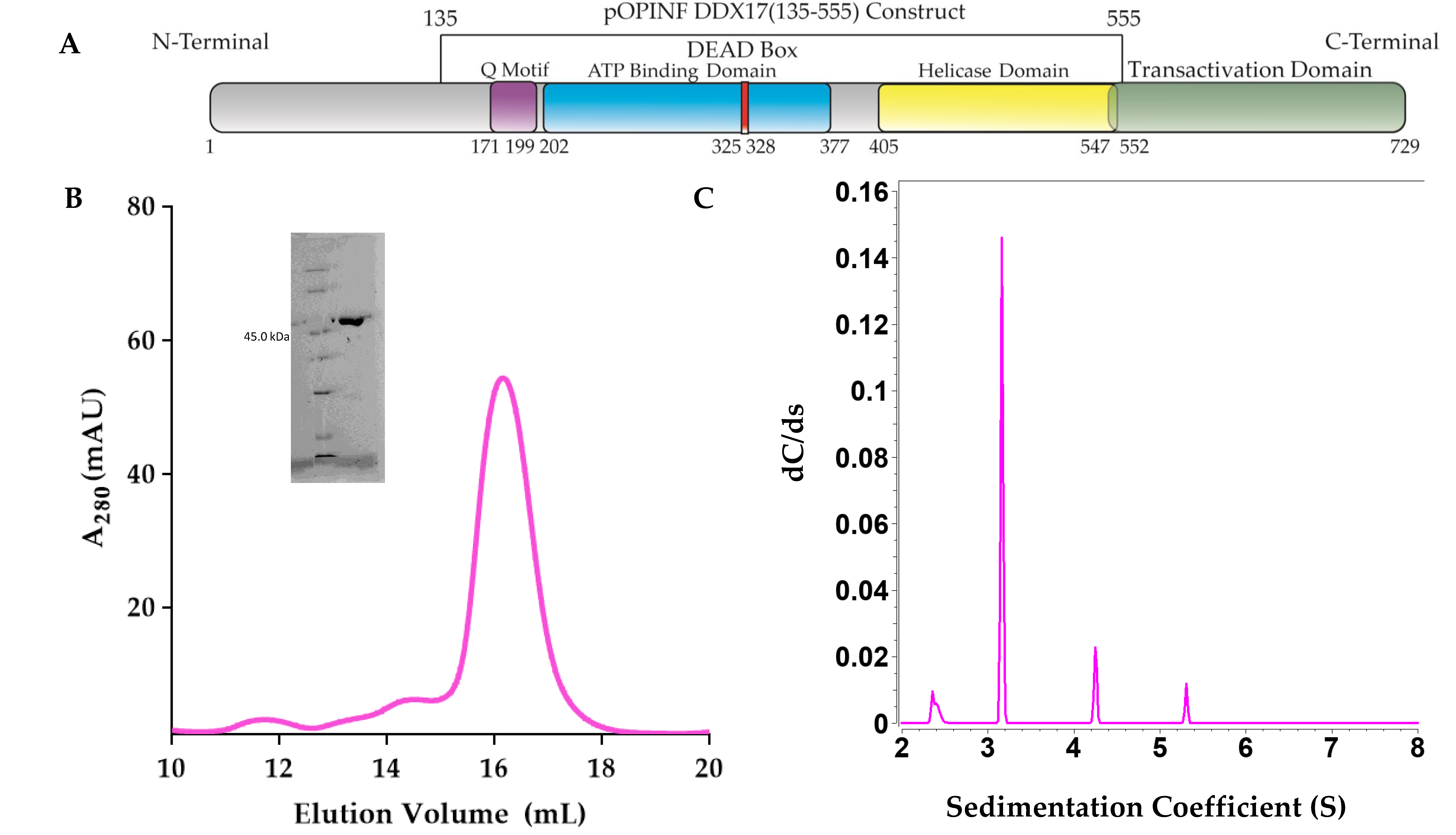
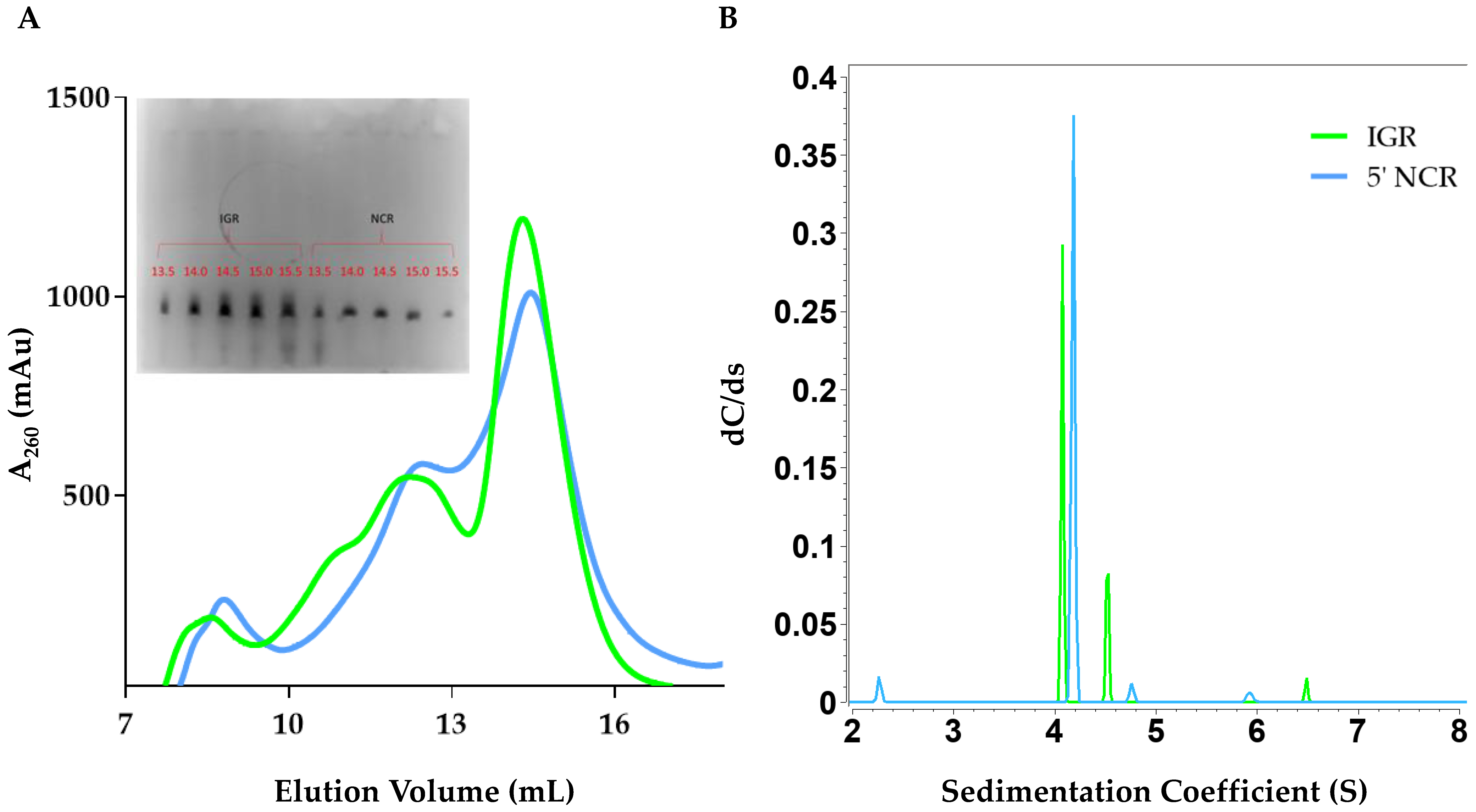
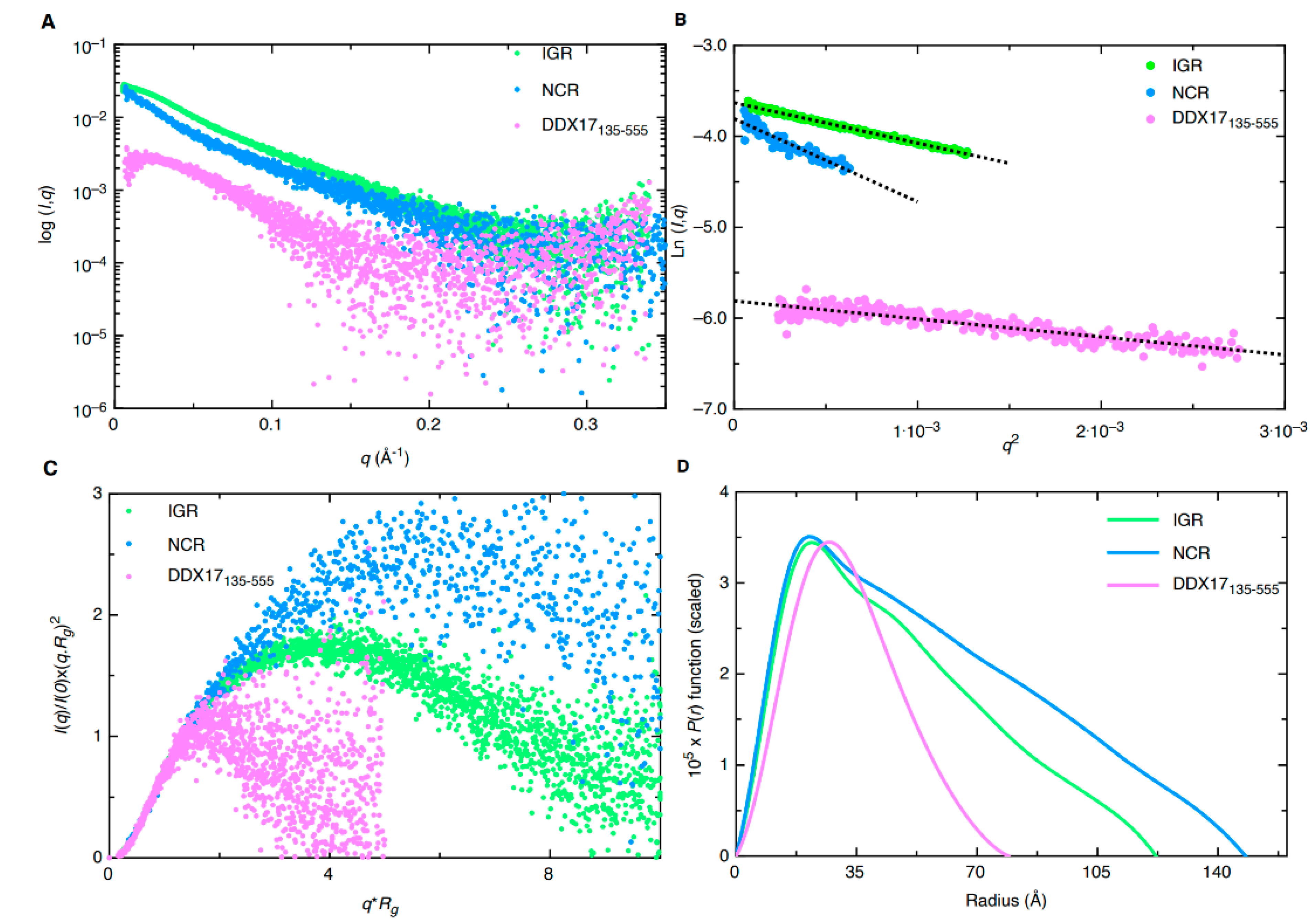
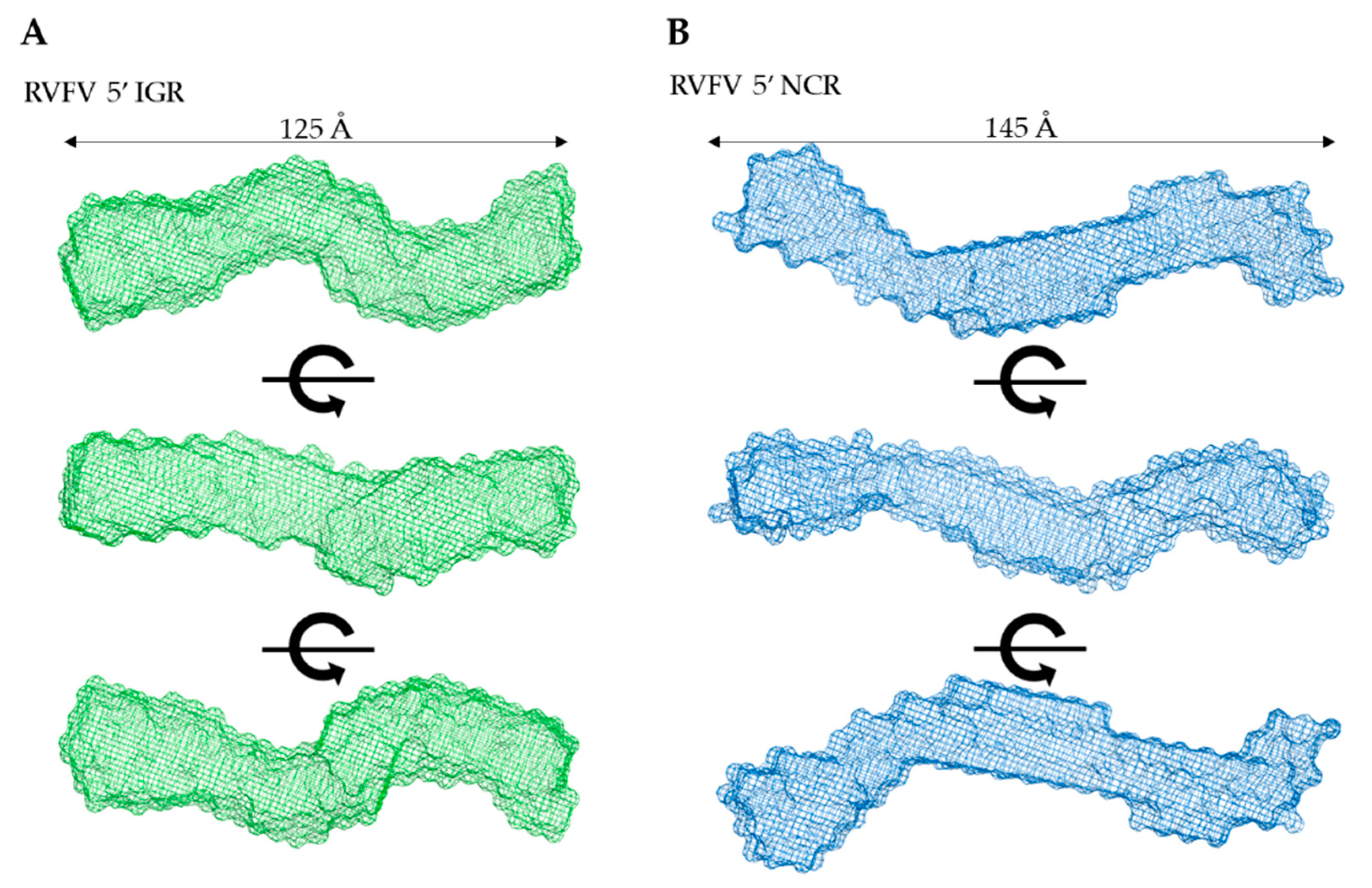

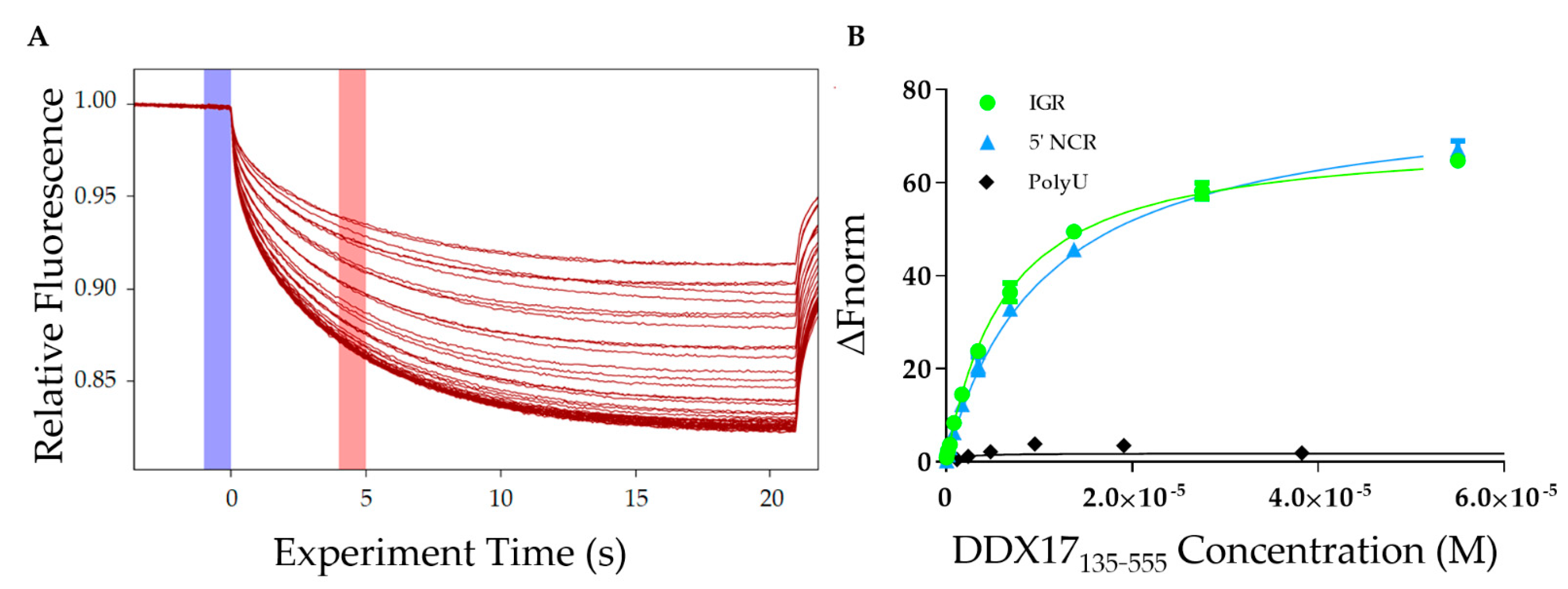
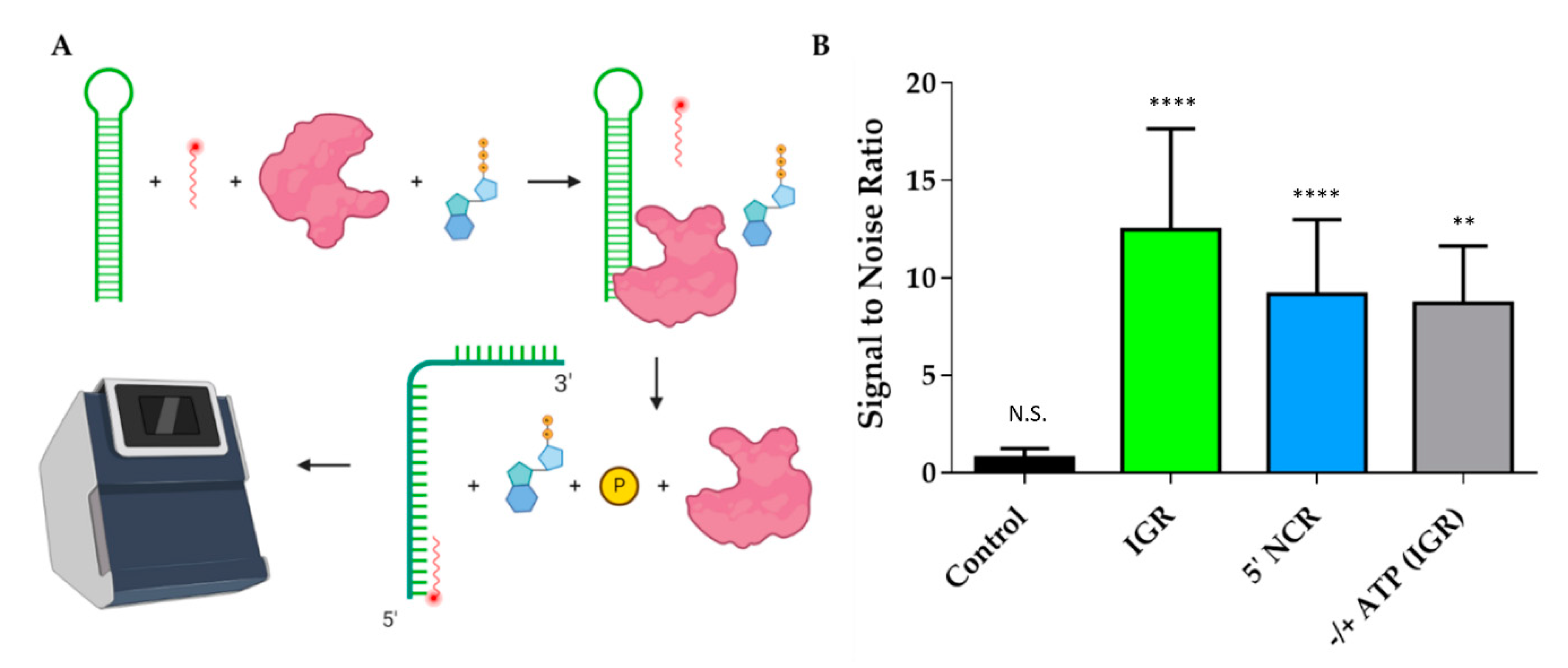
| Sample | DDX17135_555 | IGR | 5’ NCR |
|---|---|---|---|
| Mw (kDa, sequence) | 48.45 | 23.82 | 24.70 |
| Sedimentation coefficient, S (10−13 s) ∇ | 3.16 | 4.07 | 4.18 |
| Diffusion coefficient D (10−7 cm2/s) ∇ | 5.22 | 7.62 | 6.58 |
| Rh (Å) ∇ | 41.06 | 28.11 | 32.64 |
| I(0) # | 0.003 ± 2.5 × 10−5 | 0.026 ± 4.4 × 10−5 | 0.022 ± 2.6 × 10−4 |
| q.Rg range # | 0.39–1.30 | 0.26–1.29 | 0.40–1.29 |
| Rg (Å) # | 24.78 ± 0.36 | 36.42 ± 0.10 | 50.44 ± 0.88 |
| I(0) ∆ | 0.003 ± 2.3 × 10−5 | 0.026 ± 4.3 × 10−5 | 0.019 ± 1.7 × 10−4 |
| Rg (Å) ∆ | 25.46 ± 0.27 | 38.00 ± 0.08 | 46.66 ± 0.34 |
| Dmax (Å)∆ | 79.21 | 122 | 148 |
| Χ2 * | ~1.00 | ~1.10 | ~1.30 |
| NSD * | 0.52 ± 0.02 | 0.73 ± 0.02 | 0.58 ± 0.01 |
Publisher’s Note: MDPI stays neutral with regard to jurisdictional claims in published maps and institutional affiliations. |
© 2020 by the authors. Licensee MDPI, Basel, Switzerland. This article is an open access article distributed under the terms and conditions of the Creative Commons Attribution (CC BY) license (http://creativecommons.org/licenses/by/4.0/).
Share and Cite
Nelson, C.R.; Mrozowich, T.; Park, S.M.; D’souza, S.; Henrickson, A.; Vigar, J.R.J.; Wieden, H.-J.; Owens, R.J.; Demeler, B.; Patel, T.R. Human DDX17 Unwinds Rift Valley Fever Virus Non-Coding RNAs. Int. J. Mol. Sci. 2021, 22, 54. https://doi.org/10.3390/ijms22010054
Nelson CR, Mrozowich T, Park SM, D’souza S, Henrickson A, Vigar JRJ, Wieden H-J, Owens RJ, Demeler B, Patel TR. Human DDX17 Unwinds Rift Valley Fever Virus Non-Coding RNAs. International Journal of Molecular Sciences. 2021; 22(1):54. https://doi.org/10.3390/ijms22010054
Chicago/Turabian StyleNelson, Corey R., Tyler Mrozowich, Sean M. Park, Simmone D’souza, Amy Henrickson, Justin R. J. Vigar, Hans-Joachim Wieden, Raymond J. Owens, Borries Demeler, and Trushar R. Patel. 2021. "Human DDX17 Unwinds Rift Valley Fever Virus Non-Coding RNAs" International Journal of Molecular Sciences 22, no. 1: 54. https://doi.org/10.3390/ijms22010054
APA StyleNelson, C. R., Mrozowich, T., Park, S. M., D’souza, S., Henrickson, A., Vigar, J. R. J., Wieden, H.-J., Owens, R. J., Demeler, B., & Patel, T. R. (2021). Human DDX17 Unwinds Rift Valley Fever Virus Non-Coding RNAs. International Journal of Molecular Sciences, 22(1), 54. https://doi.org/10.3390/ijms22010054







